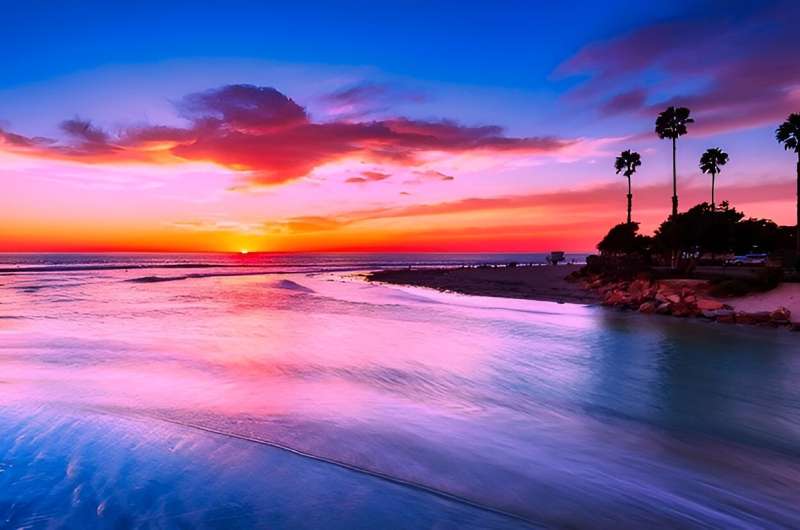This article has been reviewed according to Science X's editorial process and policies. Editors have highlighted the following attributes while ensuring the content's credibility:
fact-checked
reputable news agency
proofread
Australian firm's proposal to build headlands, artificial reef in Oceanside gets nod

A plan to build headlands and an artificial reef has been selected from three proposals by international design firms for a pilot project to restore and retain sand on Oceanside's eroded beaches.
The Australian firm International Coastal Management submitted the concept, and the headlands would be small, rounded extensions of the beach to be built at the ends of Tyson and Wisconsin streets.
The raised headlands would be protected from the waves by rock barriers, similar to the area of the beach that supports the lifeguard headquarters building beneath the Oceanside pier. Instead of a building, the raised sandy surfaces would be topped by pedestrian paths, shade structures, fencing and native dune plants.
Also part of the ICM plan is an artificial underwater reef built of rocks, cobble and sand in fabric containers just beyond the waves between the two headlands, to slow erosive forces and protect the beach. The recommended plan is scheduled to go to the Oceanside City Council for approval Jan. 31.
"Our design concept has focused on delivering a sustainable nature-based approach ... using design elements that mimic those that occur naturally in the region," the ICM proposal states.
Three teams competing for the Re:Beach contract made their final pitch Dec. 13 to a jury of 10 community leaders, regional representatives and coastal scientists selected by city administrators. The city announced the jury's recommendation last week.
If approved by the City Council, ICM will receive an award of at least $100,000 and will continue to work on a final design to be shovel-ready by the fall of 2025.
"The project team will develop final engineering plans and pursue environmental compliance for the winning design alternative," according to a Jan. 4 city news release. "The planning and environmental review process is anticipated to take one to two years, and construction could begin as early as 2026."
Construction costs are estimated at $31.4 million, and so far no funding source has been identified. Generally such projects are paid for primarily with federal and state grants.
Completion of the project also depends on obtaining approvals from federal, state and local agencies, including the California Coastal Commission.
The Coastal Commission has generally opposed installing hardened structures on the beach such as the rock-ringed headlands, but in recent months administrators appear to have softened their stance.
"We will continue to work with the city and encourage their creativity," said Kate Huckelbridge, the commission's executive director, at a meeting in November. "It's exactly the approach that we want people to take, to bring all the ideas to the table as we are trying to figure out how to adapt to sea-level rise."
Oceanside, like all coastal cities in San Diego County, has been fighting beach erosion for years. The cities have benefited from local and regional sand replenishment programs that take sediment from construction projects, riverbeds, lagoons, harbors and nearshore deposits.
The Oceanside City Council began an aggressive new approach in August 2021 when it voted to spend $1 million on plans and permits for beach groins to trap and hold sand on badly eroded beaches south of the pier. However, neighboring cities soon learned of the plan and went on record opposing groins or any hardened structure that could stop sand from flowing south in the ocean currents to their beaches.
Since then Oceanside has continued to pursue the project, but with more community outreach and an emphasis on the need to work cooperatively with other coastal cities.
"Definitely, this is a very different process and a very different project from the one we were talking about a couple years ago with groins," Oceanside Mayor Esther Sanchez said Thursday.
"This ... seems to be the one with the least impact, small headlands and small artificial reef," she said. "It's exciting that a room full of people come out with broad support for the one project. That's positive."
Other cities are still watching Oceanside's moves carefully, despite the ongoing outreach efforts.
"Once the project undergoes the required studies and analysis, we will have a better understanding of any potential impacts on other nearby coastal cities like Carlsbad," Kyle Lancaster, Carlsbad's parks and recreation director, said Monday.
"Until then, we are continuing to monitor its progress and stay in touch with the project team in Oceanside," Lancaster said.
The two other teams chosen as finalists for the Re:Beach project were Deltares/MVRDV, which proposed building a peninsula off the beach to support biodiversity and recreational activities while serving as a type of breakwater to hold sand, and SCAPE, ESA and the Dredge Research Collaborative, which proposed the concept of a sand dune park with a layered beach at Tyson Street.
2024 The San Diego Union-Tribune. Distributed by Tribune Content Agency, LLC.


















